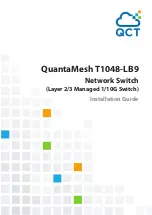
C
HAPTER
7
| Address Table Settings
Setting Static Addresses
– 187 –
S
ETTING
S
TATIC
A
DDRESSES
Use the MAC Address > Static page to configure static MAC addresses. A
static address can be assigned to a specific interface on this switch. Static
addresses are bound to the assigned interface and will not be moved.
When a static address is seen on another interface, the address will be
ignored and will not be written to the address table.
CLI R
EFERENCES
◆
"mac-address-table static" on page 754
C
OMMAND
U
SAGE
The static address for a host device can be assigned to a specific port
within a specific VLAN. Use this command to add static addresses to the
MAC Address Table. Static addresses have the following characteristics:
◆
Static addresses are bound to the assigned interface and will not be
moved. When a static address is seen on another interface, the address
will be ignored and will not be written to the address table.
◆
Static addresses will not be removed from the address table when a
given interface link is down.
◆
A static address cannot be learned on another port until the address is
removed from the table.
P
ARAMETERS
These parameters are displayed:
◆
VLAN
– ID of configured VLAN. (Range: 1-4093)
◆
Interface
– Port or trunk associated with the device assigned a static
address.
◆
MAC Address
– Physical address of a device mapped to this interface.
Enter an address in the form of xx-xx-xx-xx-xx-xx or xxxxxxxxxxxx.
◆
Static Status
– Sets the time to retain the specified address.
■
Delete-on-reset - Assignment lasts until the switch is reset.
■
Permanent - Assignment is permanent. (This is the default.)
W
EB
I
NTERFACE
To configure a static MAC address:
1.
Click MAC Address, Static.
2.
Select Add from the Action list.
3.
Specify the VLAN, the port or trunk to which the address will be
assigned, the MAC address, and the time to retain this entry.
Summary of Contents for ES3510MA
Page 1: ...Management Guide www edge core com 8 Port Layer 2 Fast Ethernet Switch...
Page 4: ...ABOUT THIS GUIDE 4...
Page 30: ...CONTENTS 30...
Page 40: ...FIGURES 40...
Page 46: ...TABLES 46...
Page 48: ...SECTION I Getting Started 48...
Page 72: ...SECTION II Web Configuration 72...
Page 88: ...CHAPTER 3 Using the Web Interface Navigating the Web Browser Interface 88...
Page 116: ...CHAPTER 4 Basic Management Tasks Resetting the System 116...
Page 154: ...CHAPTER 5 Interface Configuration VLAN Trunking 154...
Page 216: ...CHAPTER 8 Spanning Tree Algorithm Configuring Interface Settings for MSTP 216...
Page 350: ...CHAPTER 14 Security Measures DHCP Snooping 350...
Page 440: ...CHAPTER 17 IP Services Displaying the DNS Cache 440...
Page 484: ...CHAPTER 19 Using the Command Line Interface CLI Command Groups 484...
Page 554: ...CHAPTER 21 System Management Commands Switch Clustering 554...
Page 574: ...CHAPTER 22 SNMP Commands 574...
Page 582: ...CHAPTER 23 Remote Monitoring Commands 582...
Page 636: ...CHAPTER 24 Authentication Commands Management IP Filter 636...
Page 736: ...CHAPTER 29 Port Mirroring Commands RSPAN Mirroring Commands 736...
Page 816: ...CHAPTER 34 VLAN Commands Configuring Voice VLANs 816...
Page 830: ...CHAPTER 35 Class of Service Commands Priority Commands Layer 3 and 4 830...
Page 848: ...CHAPTER 36 Quality of Service Commands 848...
Page 900: ...CHAPTER 38 LLDP Commands 900...
Page 910: ...CHAPTER 39 Domain Name Service Commands 910...
Page 916: ...CHAPTER 40 DHCP Commands DHCP Client 916...
Page 948: ...CHAPTER 41 IP Interface Commands IPv6 Interface 948...
Page 950: ...SECTION IV Appendices 950...
Page 982: ...INDEX 982...
Page 983: ......
















































